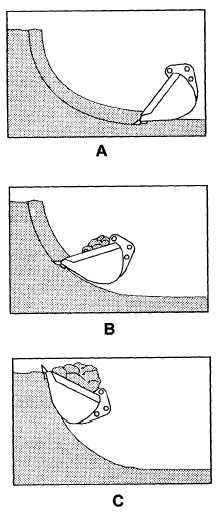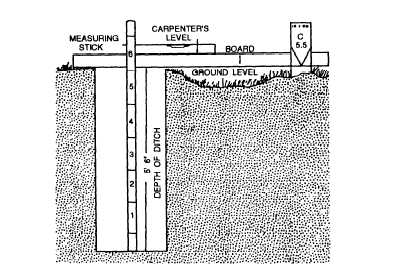Figure 9-61.—Filling the bucket.
JOB LAYOUT
Many excavation jobs are small and routine. Other
jobs may be quite extensive. On small jobs, you will
normally be shown where to dig and to what depth you
must dig. On larger jobs, you maybe shown the plan of
the proposed ditches. Grade stakes on the projects are
marked to indicate to what depth the ditches must be
excavated. (Chapter 15 covers grade stakes in detail.)
NOTE: Before starting any excavation, you must
ensure a valid digging permit is present that covers the
area you are tasked to excavate.
When arriving at the project site, you may notice
two rows of grade stakes: one row on the center line of
the proposed ditch and the other row offset a given
distance from the center line. Do not disturb the offset
stakes. They are the stakes you will follow while
excavating the ditch that have information relative to the
depth of the excavation written on the side.
9-27
Figure 9-62.—Measuring the depth of a ditch.
As a guideline, you can use a string drawn taut from
the first centerline stake to the following centerline
stakes for a distance of several hundred feet ahead of the
machine. Then spray paint over the string with a
bright-colored paint that will mark the ground to be
excavated. With the bucket centered over the first
centerline stake, you will be able to excavate the painted
line. If you get off center, you can bring the backhoe
back into alignment gradually by steering the machine
in the desired direction.
Check your grade (ditch depth) frequently. You can
do this by using a straight board, a carpenter’s level, and
a measuring stick or tape measure. Align the corner
bottom of the horizontal board on the crowfoot cut,
marking of the offset stake. Place the level on the
horizontal board and adjust the board opposite the stake
until the level indicates the board is level. Measure from
the bottom edge of the board to the bottom of the ditch,
as shown in figure 9-62. This measurement should
correspond to the amount of cut indicated on the stake.
All of the stakes will be cut stakes. You should always
try to excavate to the depth specified on the stakes.
NOTE: It is better to excavate an inch or two below
grade than not excavate deep enough.
FOUNDATION EXCAVATION
The backhoe is used to make excavations for
basements or any other square- or rectangular-shaped
job. It is also used extensively for digging wide trenches
for laying water and sewer pipe. When the backhoe is
used for the digging of square- or rectangular-shaped
jobs, the procedures may vary with the shape of the job,
restrictions caused by surrounding buildings, or special



